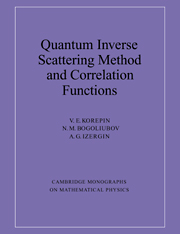Book contents
- Frontmatter
- Contents
- Preface
- Part I The Coordinate Bethe Ansatz
- Part II The Quantum Inverse Scattering Method
- Part III The Determinant Representation for Quantum Correlation Functions
- Part IV Differential Equations for Quantum Correlation Functions
- Introduction to Part IV
- XIII Correlation Functions for Impenetrable Bosons. The Determinant Representation
- XIV Differential Equations for Correlation Functions
- XV The Matrix Riemann-Hilbert Problem for Correlation Functions
- XVI Asymptotics of Temperature-dependent Correlation Functions for the Impenetrable Bose Gas
- XVII The Algebraic Bethe Ansatz and Asymptotics of Correlation Functions
- XVIII Asymptotics of Correlation Functions and the Conformal Approach
- Final Conclusion
- References
- Index
XVIII - Asymptotics of Correlation Functions and the Conformal Approach
Published online by Cambridge University Press: 04 August 2010
- Frontmatter
- Contents
- Preface
- Part I The Coordinate Bethe Ansatz
- Part II The Quantum Inverse Scattering Method
- Part III The Determinant Representation for Quantum Correlation Functions
- Part IV Differential Equations for Quantum Correlation Functions
- Introduction to Part IV
- XIII Correlation Functions for Impenetrable Bosons. The Determinant Representation
- XIV Differential Equations for Correlation Functions
- XV The Matrix Riemann-Hilbert Problem for Correlation Functions
- XVI Asymptotics of Temperature-dependent Correlation Functions for the Impenetrable Bose Gas
- XVII The Algebraic Bethe Ansatz and Asymptotics of Correlation Functions
- XVIII Asymptotics of Correlation Functions and the Conformal Approach
- Final Conclusion
- References
- Index
Summary
Introduction
The long distance asymptotics of correlation functions in integrable models have attracted long-standing interest. For the gapless one-dimensional systems considered in this book, zero temperature is a critical point. At zero temperature, (T = 0), correlation functions decay as a power of the distance, but for T > 0, correlation functions decay exponentially. The powers of the distance by which correlation functions decay at zero temperature are called the critical exponents and they are the subject of this chapter.
A recent development in the understanding of critical phenomena in (1+1)-dimensional systems is connected with conformal field theory which provides a powerful method for calculating critical exponents. However, many important results in (1+1)-dimensional systems have been obtained from perturbation calculations and renormalization group treatments, and. It should also be noted that the quantum inverse scattering method (QISM) approach to correlation functions confirms the predictions of conformal field theory (CFT), but more importantly QISM techniques show that the critical exponents of integrable models depend only on the underlying R-matrix.
The Luttinger liquid approach is very powerful; it is also close to CFT. This approach is essentially based on the representation of a critical one-dimensional model in terms of a gaussian model. In the framework of this approach, the critical exponent was calculated first for Bethe Ansatz solvable models with a single degree of freedom. One should also mention the bosonization technique.
- Type
- Chapter
- Information
- Quantum Inverse Scattering Method and Correlation Functions , pp. 502 - 517Publisher: Cambridge University PressPrint publication year: 1993



